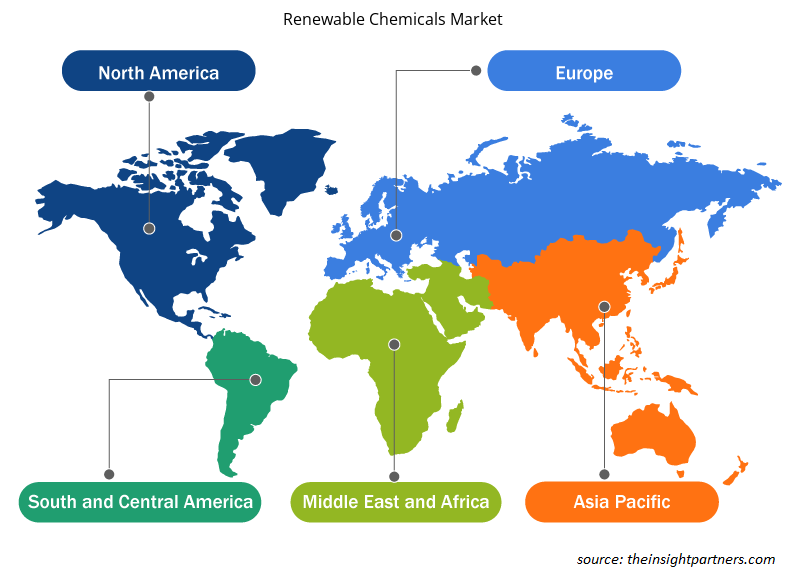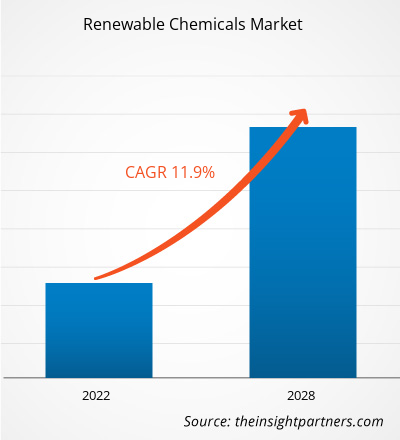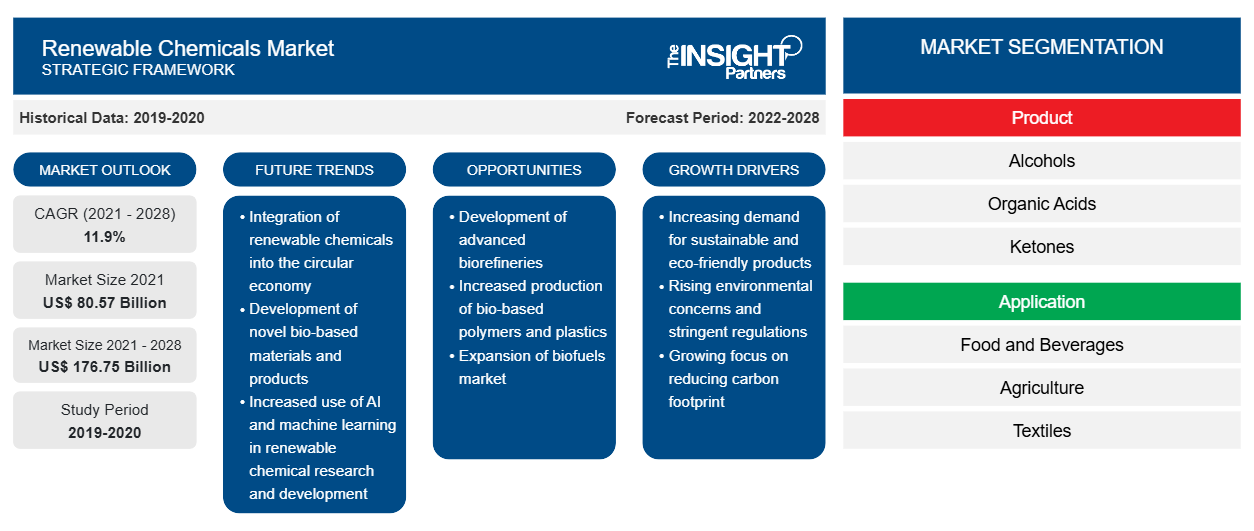بلغت قيمة سوق المواد الكيميائية المتجددة 80,566.30 مليون دولار أمريكي في عام 2021، ومن المتوقع أن تنمو بمعدل نمو سنوي مركب نسبته 11.9٪ من عام 2021 إلى عام 2028.
تُعرَّف المواد الكيميائية المتجددة أو المواد الكيميائية القائمة على المواد الحيوية بأنها تلك الفئات من المواد الكيميائية التي يتم تصنيعها من مصادر متجددة مثل المواد الخام الزراعية والنفايات الزراعية ومنتجات النفايات العضوية والكتلة الحيوية والكائنات الحية الدقيقة. تُصنَّف المواد الكيميائية المتجددة على أنها مواد كيميائية مستدامة وصديقة للبيئة تنبعث منها بصمات كربونية أقل مقارنة بالمواد الكيميائية التقليدية القائمة على البترول. بعض المواد الكيميائية المتجددة الأكثر توفرًا هي اللجنين والكربوهيدرات والزيوت ومستخلصات النباتات والهيميسليلوز والسليلوز والنشا والبروتين وغيرها. تجد هذه المواد الكيميائية تطبيقًا في قواعد تطبيق متنوعة مثل الأغذية والمشروبات والزراعة والمنسوجات والسيارات والتعبئة والتغليف وغيرها.
في عام 2021، ساهمت أمريكا الشمالية بأكبر حصة في سوق المواد الكيميائية المتجددة العالمية. ترجع هيمنة سوق المواد الكيميائية المتجددة في هذه المنطقة في المقام الأول إلى وجود قاعدة صناعية قوية مع مساهمة الشركات المصنعة البارزة بشكل كبير في نمو السوق. الطلب المرتفع على المواد الكيميائية المتجددة من تطبيقات مثل الأغذية والمشروبات والزراعة والمنسوجات والنقل والتعبئة والتغليف وغيرها من الصناعات المدعومة بنمو كبير في القواعد الصناعية للاستخدام النهائي يحفز الطلب على المواد الكيميائية المتجددة في السوق الإقليمية. يوفر ارتفاع الاستثمار في قطاع التصنيع جنبًا إلى جنب مع التركيز المتزايد على الحلول الصديقة للبيئة والمستدامة فرصًا مربحة لنمو سوق المواد الكيميائية المتجددة في أمريكا الشمالية. علاوة على ذلك، من المتوقع أن تخلق السياسات المواتية لتعزيز استخدام المواد الكيميائية الحيوية والمتجددة على المواد الكيميائية التقليدية القائمة على البترول فرص نمو مربحة في المنطقة.
قم بتخصيص هذا التقرير ليناسب متطلباتك
ستحصل على تخصيص لأي تقرير - مجانًا - بما في ذلك أجزاء من هذا التقرير، أو تحليل على مستوى الدولة، وحزمة بيانات Excel، بالإضافة إلى الاستفادة من العروض والخصومات الرائعة للشركات الناشئة والجامعات
- احصل على أهم اتجاهات السوق الرئيسية لهذا التقرير.ستتضمن هذه العينة المجانية تحليلاً للبيانات، بدءًا من اتجاهات السوق وحتى التقديرات والتوقعات.
تأثير جائحة كوفيد-19 على سوق المواد الكيميائية المتجددة
لقد غير الوباء المستمر بشكل كبير وضع القطاع الصناعي وأثر سلبًا على نمو سوق المواد الكيميائية المتجددة. أدى تنفيذ التدابير لمكافحة انتشار الفيروس إلى تفاقم الوضع وأثر على نمو العديد من القطاعات الصناعية. تأثرت الصناعات مثل الأغذية والمشروبات والزراعة والمنسوجات والنقل والتعبئة والتغليف والمستحضرات الصيدلانية بالتشوهات المفاجئة في الكفاءة التشغيلية والاضطرابات في سلاسل القيمة المنسوبة إلى الإغلاق المفاجئ للحدود الوطنية والدولية. أثر الانخفاض الكبير في نمو العديد من القطاعات الصناعية سلبًا على الطلب على المواد الكيميائية المتجددة في السوق العالمية. أثرت الاضطرابات من حيث مصادر المواد الخام من الموردين وكذلك الإغلاق المؤقت لقاعدة التصنيع بسبب عمليات الإغلاق غير المحددة والحجر الصحي المؤقت على نمو السوق خلال فترة الوباء. ومع ذلك، مع تخطيط الاقتصادات لإحياء عملياتها، من المتوقع أن يرتفع الطلب على المواد الكيميائية المتجددة عالميًا. على الرغم من أن التركيز على الإنتاج في الوقت المناسب هو عامل آخر مثير للقلق يعيق نمو السوق. ومن المتوقع أن يؤدي الطلب المتزايد على المواد الكيميائية المتجددة في قطاعات الأغذية والمشروبات والزراعة والمنسوجات والنقل والتعبئة والتغليف والأدوية وغيرها من الصناعات إلى جانب الاستثمارات الكبيرة من قبل الشركات المصنعة البارزة إلى دفع نمو المواد الكيميائية المتجددة.
رؤى السوق
الوعي المتزايد بشأن المواد الكيميائية المتجددة مدعوم بمخاوف بيئية متزايدة
لقد تم اعتبار العلوم المتجددة واحدة من الطرق الفعالة لتعزيز جودة الهواء والماء والتربة والمساهمة في الاستدامة من خلال تسويق استخدام المواد الكيميائية الحيوية الصديقة للبيئة في تطبيقات متنوعة. يمكن الحصول على المواد الكيميائية المتجددة المستدامة الصديقة للبيئة من المواد الخام المتجددة مثل الكتلة الحيوية أو المخلفات الزراعية أو المواد الخام والكائنات الحية الدقيقة بمساعدة تخليق الكيمياء الخضراء أو المصافي الحيوية. لقد نفذت حكومات العديد من الاقتصادات لوائح صارمة تتعلق بانبعاثات الكربون والغازات المسببة للانحباس الحراري العالمي لتعزيز جودة البيئة. على سبيل المثال، تهدف المفوضية الأوروبية إلى تحقيق انخفاض بنسبة 80٪ في انبعاثات الكربون بحلول عام 2050 من خلال التخلص التدريجي من حوالي 81 مليون طن من ثاني أكسيد الكربون لاستخدامه في إنتاج الكلنكر. تفرض الهيئات التنظيمية، مثل REACH (التسجيل والتقييم والترخيص وتقييد المواد الكيميائية)، ووكالة حماية البيئة (EPA)، والمفوضية الأوروبية، لوائح بيئية صارمة على إنتاج والتخلص من البتروكيماويات. كما أن التركيز المتزايد للاتحاد الأوروبي على إنشاء "الاقتصاد الأخضر" إلى جانب مبادرته "20-20-20" يعمل على التخلص التدريجي من الطلب على البتروكيماويات. إن انخفاض موارد البترول إلى جانب عدم الاستقرار السياسي في الدول المنتجة للنفط الرائدة وتقلب أسعار المنتجات البترولية يزيد من تفضيل المواد الكيميائية المتجددة. إن الانحباس الحراري العالمي وتغير المناخ يخلقان الطلب على المنتجات الصحية والخضراء والنظيفة. بالإضافة إلى ذلك، يخلق الاقتصاد الدائري أكثر من 5.6 تريليون دولار أمريكي من الفرص الجديدة لتطوير التقنيات الصديقة للبيئة بما في ذلك التكنولوجيا المرتبطة بالمواد الكيميائية المتجددة. مثل هذه الجهود التعاونية واللوائح والمبادرات تدفع نمو سوق المواد الكيميائية المتجددة.
رؤى المنتج
بناءً على المنتج، يتم تصنيف سوق المواد الكيميائية المتجددة إلى الكحولات والأحماض العضوية والكيتونات والمواد الكيميائية الأساسية والبوليمرات الحيوية وغيرها. من المتوقع أن يكون قطاع البوليمرات الحيوية هو القطاع الأسرع نموًا في سوق المواد الكيميائية المتجددة العالمية خلال فترة التنبؤ. من المتوقع أن يؤدي الطلب المتزايد على مواد التغليف الخضراء إلى جانب الاستخدام المتزايد للبوليمرات الحيوية في صناعة السيارات إلى دفع نمو البوليمرات الحيوية في سوق المواد الكيميائية المتجددة. تشمل البوليمرات الحيوية البولينيوكليوتيدات (DNA، RNA)، والسليلوز، والكيتوزان، والكيتين، والنشا، والبروتينات، والبوليستر، والبكتين، والكولاجين، والجيلاتين، والغلوتين، وغيرها. إنها بديل مبتكر وواعد للحد من انبعاثات الغازات المسببة للانحباس الحراري العالمي والسامة، واستخدام الموارد غير المتجددة. من المتوقع أن يعزز التركيز المتزايد على المواد الصديقة للبيئة والمستدامة الطلب على البوليمرات الحيوية.
رؤى التطبيق
بناءً على التطبيق، يتم تصنيف سوق المواد الكيميائية المتجددة إلى الأغذية والمشروبات والزراعة والمنسوجات والنقل والوسطاء الكيميائيين والتعبئة والتغليف والأدوية الحيوية والمستحضرات الصيدلانية وغيرها. في عام 2021، يهيمن قطاع النقل على سوق المواد الكيميائية المتجددة. يتم تحويل الكتلة الحيوية ورقائق الخشب وبقايا المحاصيل وما إلى ذلك إلى وقود نقل متجدد. تُستخدم الأنواع المختلفة من الكحوليات الحيوية مثل البيوتانول الحيوي والإيثانول الحيوي والميثانول الحيوي كوقود للطائرات النفاثة. الإيثانول الحيوي هو المصدر الأكثر استخدامًا للطاقة في النقل. من المتوقع أن يزداد استخدام الإيثانول الحيوي بشكل كبير في السنوات القادمة ويظل مرتفعًا. سيوفر هذا التحول نحو المزيد من استخدام الإيثانول الحيوي المزيد من الفرص في المستقبل. الميثان هو مادة كيميائية متجددة أخرى تستخدم كوقود للنقل وهو المكون الرئيسي للغاز الطبيعي المضغوط. يتم إنتاجه من الكتلة الحيوية من خلال عملية كيميائية حيوية تسمى الهضم اللاهوائي. الديزل الحيوي هو بديل وقود ديزل متجدد يتم إنتاجه عن طريق خلط أي زيت طبيعي أو دهون مع الكحول (عادةً الميثانول). يمكن أيضًا تحويل الزيوت النباتية المختلفة والدهون الحيوانية وشحوم الطهي المعاد تدويرها إلى وقود الديزل الحيوي.
من بين اللاعبين الرئيسيين الرئيسيين العاملين في سوق المواد الكيميائية المتجددة شركة BASF SE؛ وشركة Amyris Inc؛ وشركة DSM؛ وشركة Archer-Daniels-Midland Company (ADM)؛ وشركة Dow Chemical Company. وتركز هذه الشركات العاملة في السوق بشكل كبير على تطوير عروض المنتجات عالية الجودة والمبتكرة.
رؤى إقليمية حول سوق المواد الكيميائية المتجددة
لقد قام المحللون في Insight Partners بشرح الاتجاهات والعوامل الإقليمية المؤثرة على سوق المواد الكيميائية المتجددة طوال فترة التوقعات بشكل شامل. يناقش هذا القسم أيضًا قطاعات سوق المواد الكيميائية المتجددة والجغرافيا في جميع أنحاء أمريكا الشمالية وأوروبا ومنطقة آسيا والمحيط الهادئ والشرق الأوسط وأفريقيا وأمريكا الجنوبية والوسطى.

- احصل على البيانات الإقليمية المحددة لسوق المواد الكيميائية المتجددة
نطاق تقرير سوق المواد الكيميائية المتجددة
| سمة التقرير | تفاصيل |
|---|---|
| حجم السوق في عام 2021 | 80.57 مليار دولار أمريكي |
| حجم السوق بحلول عام 2028 | 176.75 مليار دولار أمريكي |
| معدل النمو السنوي المركب العالمي (2021 - 2028) | 11.9% |
| البيانات التاريخية | 2019-2020 |
| فترة التنبؤ | 2022-2028 |
| القطاعات المغطاة | حسب المنتج
|
| المناطق والدول المغطاة | أمريكا الشمالية
|
| قادة السوق وملفات تعريف الشركات الرئيسية |
|
كثافة اللاعبين في سوق المواد الكيميائية المتجددة: فهم تأثيرها على ديناميكيات الأعمال
يشهد سوق المواد الكيميائية المتجددة نموًا سريعًا، مدفوعًا بالطلب المتزايد من المستخدم النهائي بسبب عوامل مثل تفضيلات المستهلكين المتطورة والتقدم التكنولوجي والوعي المتزايد بفوائد المنتج. ومع ارتفاع الطلب، تعمل الشركات على توسيع عروضها والابتكار لتلبية احتياجات المستهلكين والاستفادة من الاتجاهات الناشئة، مما يؤدي إلى زيادة نمو السوق.
تشير كثافة اللاعبين في السوق إلى توزيع الشركات أو المؤسسات العاملة في سوق أو صناعة معينة. وهي تشير إلى عدد المنافسين (اللاعبين في السوق) الموجودين في مساحة سوق معينة نسبة إلى حجمها أو قيمتها السوقية الإجمالية.
الشركات الرئيسية العاملة في سوق المواد الكيميائية المتجددة هي:
- شركة آرتشر دانييلز ميدلاند (ADM)
- شركة كارغيل
- التشخيصات والإحصائيات للأمراض النفسية
- باسف اس اي.
- شركة اميريس
إخلاء المسؤولية : الشركات المذكورة أعلاه ليست مرتبة بأي ترتيب معين.

- احصل على نظرة عامة على أهم اللاعبين الرئيسيين في سوق المواد الكيميائية المتجددة
تقرير يسلط الضوء على
- اتجاهات الصناعة التقدمية في سوق المواد الكيميائية المتجددة لمساعدة اللاعبين على تطوير استراتيجيات فعالة طويلة الأجل
- استراتيجيات نمو الأعمال التي تتبناها الأسواق المتقدمة والنامية
- التحليل الكمي لسوق المواد الكيميائية المتجددة من 2019 إلى 2028
- تقدير الطلب العالمي على المواد الكيميائية المتجددة
- تحليل PEST لتوضيح فعالية المشترين والموردين العاملين في الصناعة
- التطورات الأخيرة لفهم سيناريو السوق التنافسي
- اتجاهات السوق وتوقعاتها بالإضافة إلى العوامل التي تدفع وتكبح نمو سوق المواد الكيميائية المتجددة
- المساعدة في عملية اتخاذ القرار من خلال تسليط الضوء على استراتيجيات السوق التي تدعم المصلحة التجارية، مما يؤدي إلى نمو السوق
- نظرة عامة مفصلة وتقسيم السوق، بالإضافة إلى ديناميكيات صناعة المواد الكيميائية المتجددة
- حجم سوق المواد الكيميائية المتجددة في مناطق مختلفة مع فرص نمو واعدة
سوق المواد الكيميائية المتجددة حسب المنتج
- الكحوليات
- الأحماض العضوية
- الكيتونات
- المواد الكيميائية الأساسية
- البوليمرات الحيوية
- آحرون
سوق المواد الكيميائية المتجددة حسب التطبيق
- الأطعمة والمشروبات
- زراعة
- المنسوجات
- مواصلات
- المواد الوسيطة الكيميائية
- التعبئة والتغليف
- الطب الحيوي والأدوية
- آحرون
نبذة عن الشركة
- شركة آرتشر دانييلز ميدلاند (ADM)
- شركة كارغيل
- التشخيصات والإحصائيات للأمراض النفسية
- باسف اس اي
- شركة اميريس
- شركة إيفونيك للصناعات
- سولفاي
- شركة داو للكيماويات
- جينوماتيكا، المحدودة
- براسكيم
- التحليل التاريخي (سنتان)، سنة الأساس، التوقعات (7 سنوات) مع معدل النمو السنوي المركب
- تحليل PEST و SWOT
- حجم السوق والقيمة / الحجم - عالمي، إقليمي، بلد
- الصناعة والمنافسة
- مجموعة بيانات إكسل
التقارير الحديثة
تقارير ذات صلة
شهادات العملاء
سبب الشراء
- اتخاذ قرارات مدروسة
- فهم ديناميكيات السوق
- تحليل المنافسة
- رؤى العملاء
- توقعات السوق
- تخفيف المخاطر
- التخطيط الاستراتيجي
- مبررات الاستثمار
- تحديد الأسواق الناشئة
- تحسين استراتيجيات التسويق
- تعزيز الكفاءة التشغيلية
- مواكبة التوجهات التنظيمية





















 احصل على عينة مجانية ل - سوق المواد الكيميائية المتجددة
احصل على عينة مجانية ل - سوق المواد الكيميائية المتجددة